The ASUS ZenFone 7 Pro Review: The Triple Flip-Camera
by Andrei Frumusanu on September 1, 2020 3:00 AM EST- Posted in
- Mobile
- Asus
- Smartphones
- ZenFone 7
- ZenFone 7 Pro
System Performance
System performance of the ZenFone 7 Pro is quite a bit more straightforward than what we’ve seen last week on the ROG Phone III – the mainstream device lacks the more complicated performance modes that the gaming-oriented sibling exposes to its users. Instead, we’re seeing a relatively simplified choice in regards to refresh rates: 60 or 90Hz, and a “high performance” mode.
Unfortunately, this high-performance mode functions the same as the higher performance X-modes on the ROG Phone III in that it essentially just disables DVFS and just runs the SoC at maximum frequencies all the time. It’s not a mode that I would recommend anybody to run their phone on, unless you really don’t care at all about battery life.
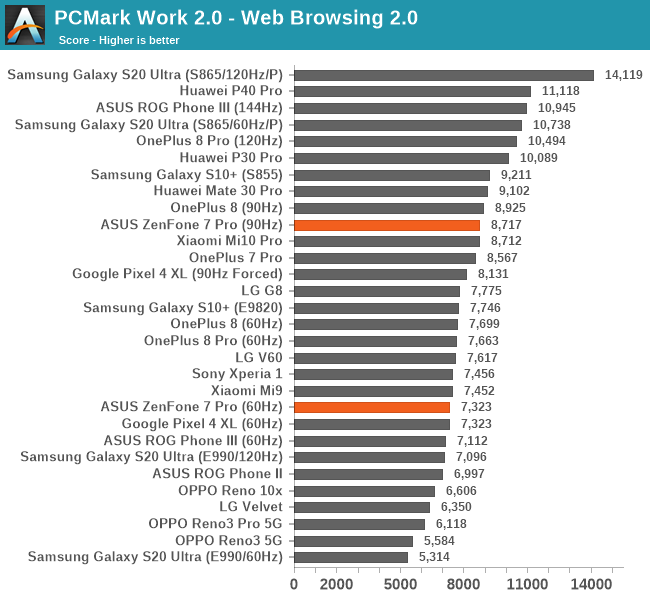
In PCMark’s web-browsing test the scores essentially line up with the refresh rate, and the ZenFone 7 Pro tracks the results of the ROG Phone III at 60Hz, and landing in-between at 90Hz.

In the important writing test, the ZenFone also performed extremely well and represented amongst the better Snapdragon 865 devices.
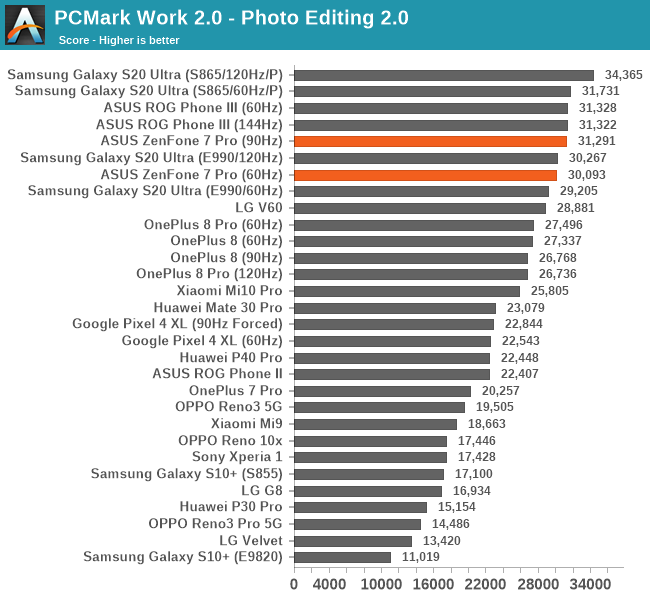
Photo editing is also performing excellently and again slightly ahead of some other S865 phones.
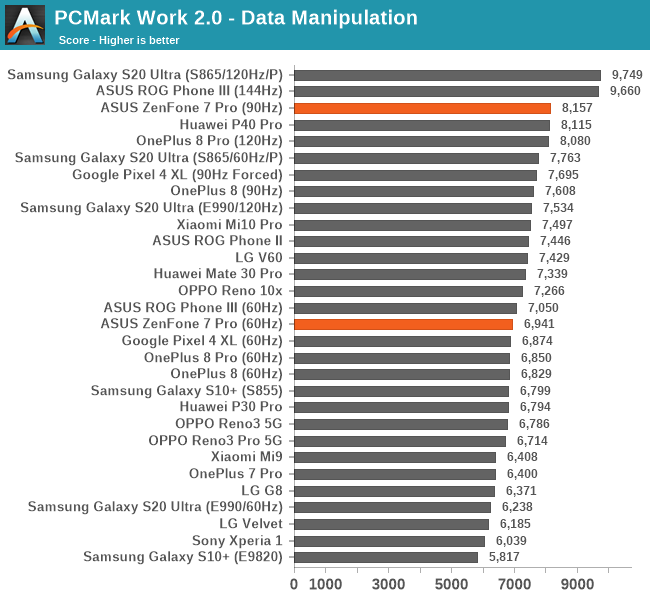
The data-manipulation scaled with the refresh rate bump so it means the ZenFone is able to render frames within the expected 12ms frame-time limit.
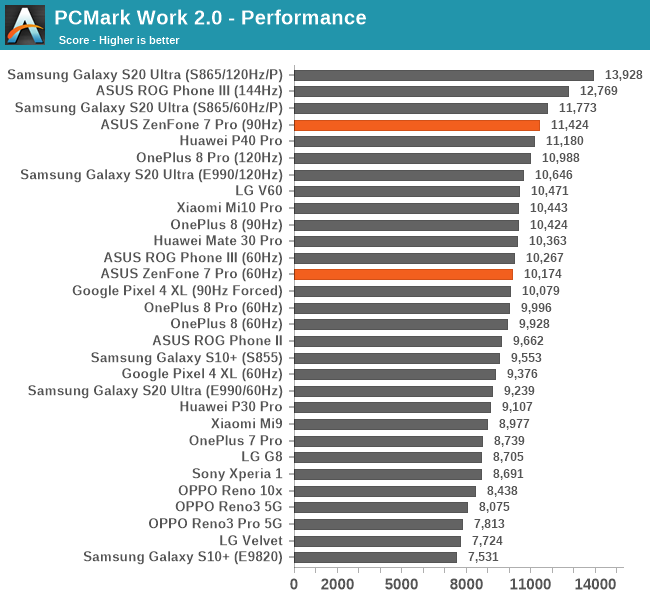
Overall, the ZenFone 7 Pro performed quite well in PCMark and there’s not much we can complain about in regards to its performance.
One thing I need to make note is that I’ve noticed that ASUS is doing some sort of benchmark detection on its phones. On both the ROG Phone III and this new ZenFone 7 Pro I’ve noted that the system detected PCMark. Unlike other detection mechanisms that raise performance in benchmarks, ASUS’s behaviour here seems to have been to force the 60Hz mode, even when 90Hz was enabled in the settings. Using an anonymised version of PCMark bypassed the detection and I was able to get the 90Hz scores and battery life tests. I’ve reached out to ASUS for comment on this, and I’ll update the matter when I hear back a response.
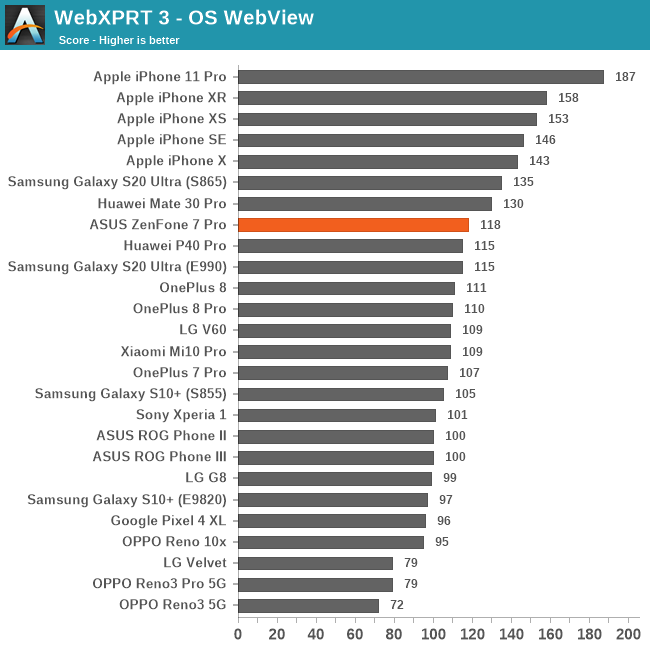
In WebXPRT3 the ZenFone 7 Pro performed significantly better than the ROG Phone III – I’m not sure what’s changed on the OS side of things but it looks like the ZenFone is slightly more aggressively tuned for performance by default.
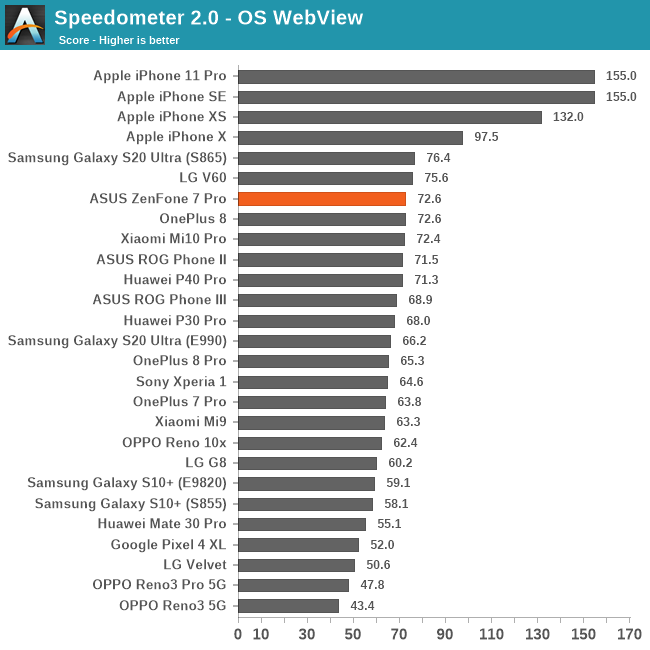
Speedometer 2.0 also doesn’t showcase the same performance oddities as seen on the ROG Phone III and we get top scores here.
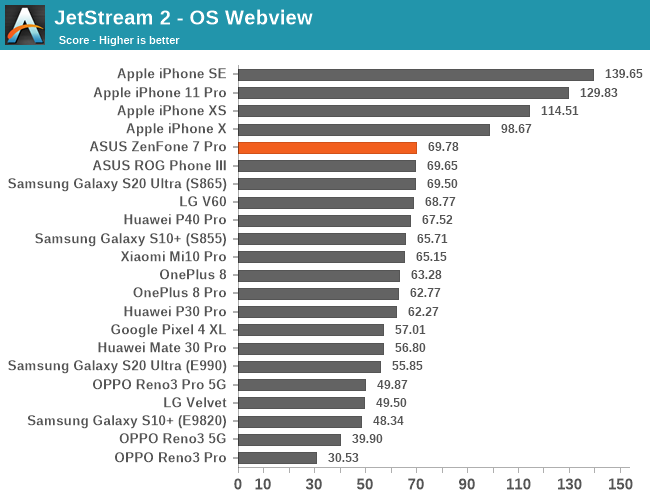
Similarly, JetStream 2 lands where we expect it to.
Overall, performance of the ZenFone 7 Pro is excellent and top-notch amongst current flagship devices. It doesn’t have the 120 or 144Hz refresh rate of some other phones in the market, but 90Hz already marks the biggest jump in user experience, and thanks to the 200Hz touch sampling rate it also gives the feel of an extremely responsive device.










31 Comments
View All Comments
GC2:CS - Tuesday, September 1, 2020 - link
I find the battery lifespan saving max charge limit comparison somewhat dishonest.For the same usage you need 500 cycles at 80 and just 400 if you charge to 100. So it is more like 7 and 12% degradation.
I think limiting charge might be usefull for things like headphones. They just sit for days in their case charged to 100%.
Also I am quite woried where we are going with battery capacities. Looks like even 4000+ mAh is not a guarantee of great battery life these days.
CampGareth - Tuesday, September 1, 2020 - link
That's assuming you drop to 0% charge every single time, under that usage you're going to burn through batteries regardless. The state of charge limit is intended more for folks that stay at a high charge percentage. I can't remember the last time my phone dropped below 60%, it's on charge at home and at work so spends a lot of time sitting at 100% charge which degrades the battery faster even when it's idle.imoc - Tuesday, September 1, 2020 - link
Not true. Their graph states SoC(State of charge) and charge cycle doesn't mean Any%-80%, a full 100% battery top up counts as one(such as 30-80 two times).close - Tuesday, September 1, 2020 - link
There are a few trends to dislike, small batteries for the consumers attached to the phone (mega SoCs, gazillion Hz screens, all of the Gs, all the time), glass backs especially when not actually needing it, removing the headphone jack even on phones that are clearly big enough to fit one, etc. This phone ticks most of them.SirDragonClaw - Tuesday, September 1, 2020 - link
You need to learn how modern batteries work...huyhung411991 - Tuesday, September 1, 2020 - link
First paragraph in Battery Life section is repeated.Ryan Smith - Tuesday, September 1, 2020 - link
Thanks!linuxgeex - Tuesday, September 1, 2020 - link
Before I even look at image quality with video recording, I pay attention to the background noise. You should be able to tap the screen, adjust volume up and down, power the screen on and off, and walk in light wind without hearing distracting sounds. This camera failed this basic requirement with flying colours lol.Kangal - Tuesday, September 1, 2020 - link
Dunno, it's hard to judge the quality without a reference.The photo, video, microphone comparisons should have something like a Sony A7 + Lav, as that's basically professional quality, and it would be much easier to spot where phone's deficiencies lay.
Bonus points should be made to compare all devices on a quick Auto Mode, but Manual-Professional Adjustment on the Mirrorless. That's the most important comparison. And do it in Good Lighting, Overcast, and Low-light conditions. And do it in Macro, Regular, and Zoom modes.
Manual Modes are interesting on the new Sony Xperia 1 ii Pro, and LG V60... but are somewhat gimmicky. Phones are meant for quick "point and shoot", for professional quality you can't subsidise a phone with manual mode for a proper DSLR or Mirrorless. It would be like trying to use a hot-hatch to move heavy loads, then complaining, instead of using a pickup truck.
linuxgeex - Tuesday, September 1, 2020 - link
@Andrei - several of the camera comparison photos are missing and some are backwards.